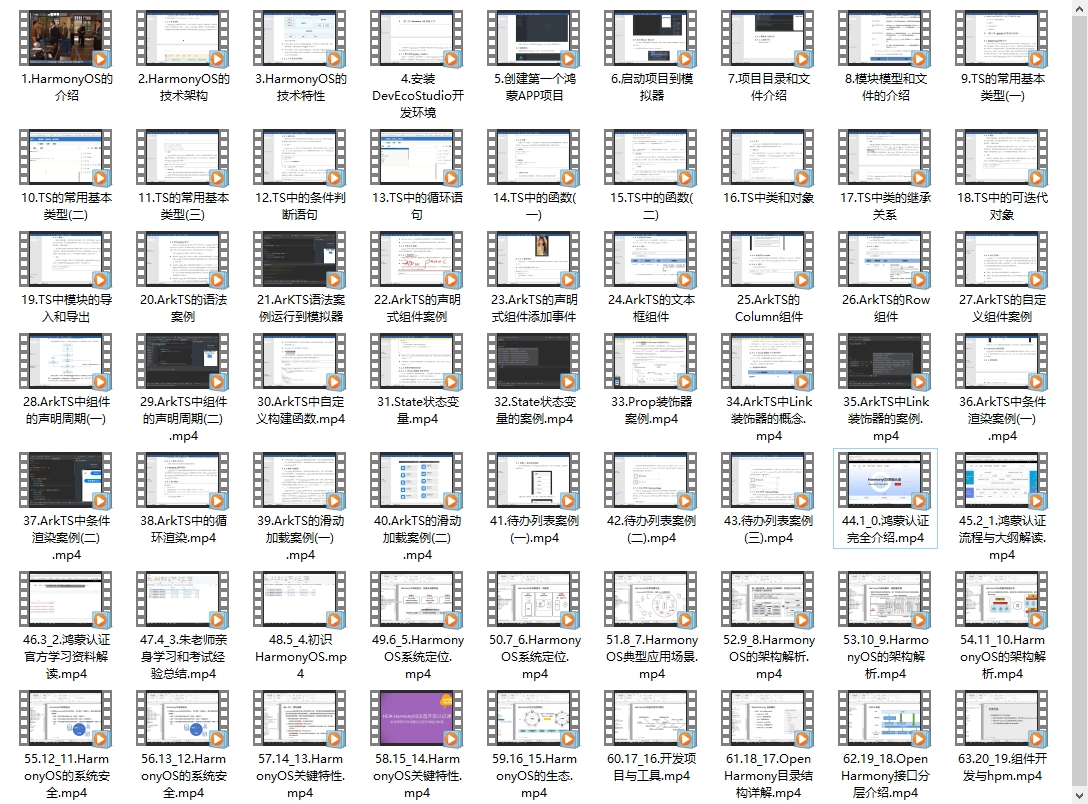场景一:对图片进行放大、缩小、拖拽移动,且放大过程中也可同时进行拖拽操作
方案
1、使用组合手势GestureGroup,同时绑定捏合手势PinchGesture和滑动手势PanGesture,设置组合手势识别模式为并行识别模式:Parallel,并行识别组合手势中注册的手势将同时进行识别,直到所有手势识别结束,并行识别手势组合中的手势进行识别时互不影响。
2、在对图片进行双指捏合时,优先触发绑定的PinchGesture手势,对图片进行缩放操作;当滑动拖拽图片时,识别绑定的PanGesture手势,对图片进行拖拽移动。
核心代码
1、绑定组合手势GestureGroup,设置为并行识别模式,添加捏合手势PinchGesture和滑动手势PanGesture。
@Styles
onImageGesture(){
.gesture(
GestureGroup(GestureMode.Parallel,
// 双指捏合手势
PinchGesture({ fingers: 2, distance: 0.1 })
.onActionUpdate((event: GestureEvent) => {
this.onPinchGestureActionUpdate(event);
})
.onActionEnd(() => {
this.onPinchGestureActionEnd();
}),
// 拖动手势
PanGesture(this.panOption)
.onActionUpdate((event?: GestureEvent) => {
this.onPanGestureActionUpdate(event);
})
.onActionEnd(() => {
this.onPanGestureActionEnd();
})
)
)
}2、在捏合手势的onActionUpdate和onActionEnd回调中修改scale参数,进行图片缩放处理。
// 当捏合手势触发时,可以通过回调函数获取缩放比例,从而修改组件的缩放比例
onPinchGestureActionUpdate(event: GestureEvent) {
const SCALE_VALUE = this.pinchValue * event.scale;
if (SCALE_VALUE <= this.imageMeta.MAX_SCALE_VALUE && SCALE_VALUE >= this.MIN_SCALE) {
this.scaleValue = SCALE_VALUE;
this.pinchX = event.pinchCenterX;
this.pinchY = this.getPinchY(event.pinchCenterY);
if (this.scaleValue > 1) {
this.offsetX = 0;
}
}
}
getPinchY(pinchCenterY: number | string) {
let pinchY = pinchCenterY;
if (this.scaleValue > 1) {
// 当为横图时,在留白处放大,图片位置不居中,手动计算pinchY,并移动Y轴中心点,即offsetY
if (this.imageMeta.IMAGE_WIDTH >= this.imageMeta.IMAGE_HEIGHT) {
const SCREEN_HEIGHT = px2vp(display.getDefaultDisplaySync().height);
const MIN_PINCH_Y = SCREEN_HEIGHT / 2 - this.imageMeta.IMAGE_HEIGHT / 2;
const MAX_PINCH_Y = SCREEN_HEIGHT / 2 + this.imageMeta.IMAGE_HEIGHT / 2;
const MIDDLE_PINCH_Y = SCREEN_HEIGHT / 2;
if (pinchY < MIN_PINCH_Y) {
pinchY = MIN_PINCH_Y;
}
if (pinchY > MAX_PINCH_Y) {
pinchY = MAX_PINCH_Y;
}
if (pinchY < MIDDLE_PINCH_Y && typeof this.pinchY === 'number') {
this.offsetY = (Number(pinchY) - MIDDLE_PINCH_Y) * (this.scaleValue - 1);
}
if (pinchY > MIDDLE_PINCH_Y && typeof this.pinchY === 'number') {
this.offsetY = (Number(pinchY) - MIDDLE_PINCH_Y) * (this.scaleValue - 1);
}
}
}
return pinchY;
}
// 当捏合手势结束时,计算当前的isScaling
// 如果缩放比例小于1,弹簧效果重置成原比例
onPinchGestureActionEnd() {
this.pinchValue = this.scaleValue;
if (this.pinchValue > 1) {
this.scaleEnable();
} else {
this.scaleUnEnable();
if (this.pinchValue < 1) {
this.reset();
}
}
}场景二:图片在放大的情况下也可切换到后一张图或者前一张图
方案
1、在panGesture手势的onActionUpdate回调中获取偏移位置,计算图片放大后分别往左或者往右拖动时是否到达边界,记录向左或向右边界的状态。
2、在onTouch事件中识别手指滑动方向,并判断边界是翻页还是拖动,方向为左右且到达边界,执行scaleUnEnable方法,将panGesture手势方向置为none,执行翻页;反之执行滑动手势,不翻页。
核心代码
1、在PanGesture手势的onActionUpDate回调中获取偏移位置,计算拖拽过程中左右两边分别是否已到边界。
// 当拖动手势触发时,可以通过回调函数获取偏移位置,并计算是否已到边界,不可拖出边界
onPanGestureActionUpdate(event: GestureEvent) {
if (!event || this.scaleValue <= 1) {
return;
}
let boundaryOffset: BoundaryOffset = {
left: 0,
right: 0,
top: 0,
bottom: 0
};
this.xBoundary = HorizontalBoundary.MIDDLE;
this.yBoundary = VerticalBoundary.MIDDLE;
const CENTER_X_RELATIVE = typeof this.pinchX === 'number' ? this.pinchX / this.imageMeta.IMAGE_WIDTH : 0.5;
boundaryOffset.left = this.imageMeta.IMAGE_WIDTH * (this.scaleValue - 1) * CENTER_X_RELATIVE;
boundaryOffset.right = -this.imageMeta.IMAGE_WIDTH * (this.scaleValue - 1) * (1 - CENTER_X_RELATIVE);
const NEWOFFSET_X = this.positionX + event.offsetX;
// 更新x轴偏移位置
if (NEWOFFSET_X <= boundaryOffset.left && newOffsetX >= boundaryOffset.right) {
// 在中间
this.offsetX = NEWOFFSET_X;
} else {
// 在边界
if (this.fingerDirection === FingerDirection.LEFT && this.offsetX !== boundaryOffset.right) {
this.offsetX = boundaryOffset.right;
}
if (this.fingerDirection === FingerDirection.RIGHT && this.offsetX !== boundaryOffset.left) {
this.offsetX = boundaryOffset.left;
}
}
// 在左边界
if (NEWOFFSET_X >= boundaryOffset.left) {
this.xBoundary = HorizontalBoundary.LEFT;
}
// 在右边界
if (NEWOFFSET_X <= boundaryOffset.right) {
this.xBoundary = HorizontalBoundary.RIGHT;
}
if (this.imageMeta.PAN_DIRECTION === PanDirection.All || this.imageMeta.PAN_DIRECTION === PanDirection.Vertical||this.imageMeta.PAN_DIRECTION === PanDirection.Horizontal) {
// 更新y轴偏移量
const NEWOFFSET_Y = this.positionY + event.offsetY;
this.offsetY = NEWOFFSET_Y;
}
}2、通过绑定onTouch事件,在滑动的过程中根据手指方向和是否到达边界通过isPageChangeOnBoundary方法判断后分别执行scaleEnable和scaleUnEnable方法进行翻页或者拖动处理。
// 识别手指滑动方向,并判断边界是翻页还是拖动
@Styles
onImageTouch(){
.onTouch((event: TouchEvent) => {
if (this.scaleValue > 1) {
if (event.type === TouchType.Down) {
this.touchPos.x = event.touches[0].x;
this.touchPos.y = event.touches[0].y;
}
if (event.type === TouchType.Move) {
this.fingerDirection = getMoveFingerDirection(this.touchPos, event, this.fingerDirection);
if (!isPageChangeOnBoundary(this.fingerDirection, this.xBoundary)) {
if (!this.isScaling) {
this.touchFlag = 1;
this.scaleEnable();
this.xBoundary = HorizontalBoundary.MIDDLE;
this.temp = this.offsetX;
this.tempY = this.offsetY;
}
}
}
if (event.type === TouchType.Up) {
if (this.touchFlag == 1) {
this.onPanGestureActionEnd();
}
this.touchFlag = 0;
this.temp = 0;
this.tempY = 0;
if (isPageChangeOnBoundary(this.fingerDirection, this.xBoundary) || this.scaleValue === 1) {
this.scaleUnEnable();
} else {
this.scaleEnable();
}
}
}
})
}
// 拖动,不翻页
scaleEnable() {
if (this.isScaling) {
return;
}
this.panOption.setDirection(this.imageMeta.PAN_DIRECTION);
this.isScaling = true;
}
// 不能拖动,翻页
scaleUnEnable() {
if (!this.isScaling) {
return;
}
this.panOption.setDirection(PanDirection.None);
this.isScaling = false;
}3、在isPageChangeOnBoundary 方法中根据传入的手指滑动方向和拖动到达的边界方向来判断返回,之后再分别调用不同场景下的方法处理逻辑,进行翻页或者拖动。
// 在边界进行翻页
export const isPageChangeOnBoundary = (fingerDirection: FingerDirection, xBoundary: HorizontalBoundary) => {
return (fingerDirection === FingerDirection.LEFT && xBoundary === HorizontalBoundary.RIGHT ||
fingerDirection === FingerDirection.RIGHT && xBoundary === HorizontalBoundary.LEFT);
}最后
小编在之前的鸿蒙系统扫盲中,有很多朋友给我留言,不同的角度的问了一些问题,我明显感觉到一点,那就是许多人参与鸿蒙开发,但是又不知道从哪里下手,因为资料太多,太杂,教授的人也多,无从选择。有很多小伙伴不知道学习哪些鸿蒙开发技术?不知道需要重点掌握哪些鸿蒙应用开发知识点?而且学习时频繁踩坑,最终浪费大量时间。所以有一份实用的鸿蒙(HarmonyOS NEXT)文档用来跟着学习是非常有必要的。
为了确保高效学习,建议规划清晰的学习路线,涵盖以下关键阶段:
点击 →【纯血版鸿蒙全套最新学习文档】希望这一份鸿蒙学习文档能够给大家带来帮助~
鸿蒙(HarmonyOS NEXT)最新学习路线

该路线图包含基础技能、就业必备技能、多媒体技术、六大电商APP、进阶高级技能、实战就业级设备开发,不仅补充了华为官网未涉及的解决方案
路线图适合人群:
IT开发人员:想要拓展职业边界
零基础小白:鸿蒙爱好者,希望从0到1学习,增加一项技能。
技术提升/进阶跳槽:发展瓶颈期,提升职场竞争力,快速掌握鸿蒙技术
2.学习视频+学习PDF文档
HarmonyOS Next 最新全套视频教程 (鸿蒙语法ArkTS、TypeScript、ArkUI教程……)

纯血版鸿蒙全套学习文档(面试、文档、全套视频等)

鸿蒙APP开发必备

总结
总的来说,华为鸿蒙不再兼容安卓,对程序员来说是一个挑战,也是一个机会。只有积极应对变化,不断学习和提升自己,才能在这个变革的时代中立于不败之地。

























 407
407

 被折叠的 条评论
为什么被折叠?
被折叠的 条评论
为什么被折叠?








